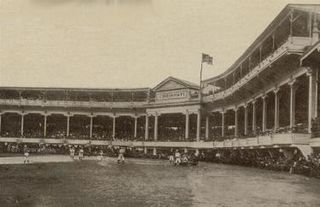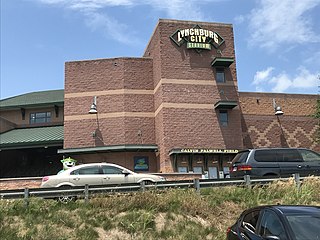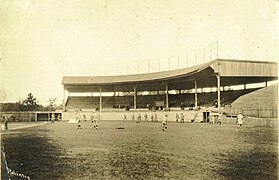
Metropolitan Stadium was an outdoor sports stadium in the north central United States, located in Bloomington, Minnesota, a suburb south of Minneapolis.

Camping World Stadium is a stadium in Orlando, Florida, located in the West Lakes neighborhood of Downtown Orlando, west of new sports and entertainment facilities including the Amway Center, the Dr. Phillips Center for the Performing Arts, and Exploria Stadium. It opened in 1936 as Orlando Stadium and has also been known as the Tangerine Bowl and Florida Citrus Bowl. The City of Orlando owns and operates the stadium.

The Montgomery Biscuits are a Minor League Baseball team based in Montgomery, Alabama. They are the Double-A affiliate of the Tampa Bay Rays and play in the Southern League. The team was founded in Orlando, Florida, in 1973 as the Orlando Twins, an affiliate of the Minnesota Twins. After remaining in the Minnesota minor league organization for 20 seasons, the team became an affiliate of the Chicago Cubs for four seasons and then the Seattle Mariners for one. In 1999, the team became an affiliate of the Tampa Bay Rays, and they have remained in the organization ever since. They became members of the Double-A South in 2021, though this was renamed the Southern League in 2022.
Several different minor league baseball teams have called the city of Orlando, Florida home from 1919–2003. Most have played in the Florida State League.

Sportsman's Park was the name of several former Major League Baseball ballpark structures in St. Louis, Missouri. All but one of these were located on the same piece of land, at the northwest corner of Grand Boulevard and Dodier Street, on the north side of the city.

Joseph Bert Tinker was an American professional baseball player and manager. He played from 1902 through 1916 for the Chicago Cubs and Cincinnati Reds of Major League Baseball (MLB) and the Chicago Whales of the Federal League.

Griffith Stadium stood in Washington, D.C., from 1911 to 1965, between Georgia Avenue and 5th Street, and between W Street and Florida Avenue NW.

National League Park, commonly referred to as the Baker Bowl after 1923, was a baseball stadium and home to the Philadelphia Phillies from 1887 until 1938, and first home field of the Philadelphia Eagles from 1933 to 1935. It opened in 1887 with a capacity of 12,500, burned down in 1894, and was rebuilt in 1895 as the first ballpark constructed primarily of steel and brick, and first with a cantilevered upper deck. The ballpark's first base line ran parallel to Huntingdon Street; right field to center field parallel to N Broad Street; center field to left field parallel to Lehigh Avenue; and the third base line parallel to 15th Street. The stadium was demolished in 1950.

Palace of the Fans was a Major League baseball park located in Cincinnati, Ohio. It was the home of the Cincinnati Reds from 1902 through 1911. The ballpark was on an asymmetrical block bounded by Findlay Street (south), Western Avenue, York Street (north) and McLean Avenue (west).
Populous is a global architectural and design practice specializing in sports facilities, arenas and convention centers, as well as the planning and design of major special events.
The Stadium at the ESPN Wide World of Sports is a baseball stadium located at the ESPN Wide World of Sports Complex in the Walt Disney World Resort. The stadium was built in 1997. It was most recently the home of the Rookie-league GCL Braves, until they moved to CoolToday Park in North Port.

A ballpark is a place where baseball is played. The playing field is divided into the infield, an area whose dimensions are rigidly defined, and the outfield, where dimensions can vary widely from place to place.

FNB Field is a baseball park in Harrisburg, Pennsylvania, USA, located on City Island, in the Susquehanna River. It is the home field of the Harrisburg Senators, the Double-A Eastern League affiliate of the Washington Nationals, and was the home stadium of Penn FC of the USL. The original structure was built in 1987 and it was called Riverside Stadium until 2004. Currently, the ballpark has a capacity of 6,187 people. The ballpark received a $45 million renovation that began in 2008.

Bank of the James Stadium, located in Lynchburg, Virginia, was originally constructed in 1939 to be used as a complex for professional baseball teams. The baseball stadium was built in conjunction with an adjacent 6,000-person football stadium. The New York Yankees and the Brooklyn Dodgers played in the inaugural game at City Stadium on April 11, 1940 in front of an estimated crowd of 7,000. The following professional baseball teams have all fielded affiliates of their parent club in Lynchburg: the Washington Senators, St. Louis Cardinals, Chicago White Sox, Minnesota Twins, Texas Rangers, New York Mets, Boston Red Sox, Pittsburgh Pirates, Cincinnati Reds, and Atlanta Braves. The stadium is currently home to the Lynchburg Hillcats of the Low-A East, and is one of the oldest active ballparks in Minor League Baseball. The Hillcats have been an affiliate of the Cleveland Indians since 2015. From 2010–2014 they were affiliated with the Atlanta Braves. In 2005, the Hillcats set an attendance record with a total of 151,266 fans passing through the gates.

The Terry Park Ballfield is a historic site in Fort Myers, Florida, United States. The park is named after the family who donated the land in the 1920s. For years the stadium hosted Major League Baseball spring training, as well as a dozen years of Florida State League baseball. The stadium hosted the Philadelphia Athletics, Cleveland Indians, Pittsburgh Pirates, and Kansas City Royals spring training through the years. Terry Park was also home to some early minor league baseball, most notably the Fort Myers Palms and Fort Myers Royals, both belonging to the Florida State League. Hall of Famers Babe Ruth, Ty Cobb, Roberto Clemente, Jimmy Foxx, Bob Feller, Tris Speaker, and George Brett are some of the notable players who have played at Terry Park Field.
Orlando, Florida has a history of major events in sports. It has had a considerable measure of success in minor league sports as well, with teams winning several minor league championships.
A total of twenty-nine sports venues were used for the 1996 Summer Olympics.
Cooke Field was a stadium located in Leesburg, Florida, used primarily for baseball and football. The stadium was named after R.F.E. Cooke, a local banker, and had been the site of local baseball games.
The Orlando Nationals were a minor league baseball team based in Orlando, Florida. In 1942, the Orlando Nationals played as members of the Rookie level Florida East Coast League, winning the league championship in a shortened season. The Nationals hosted minor league home games at Tinker Field.



















